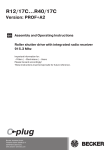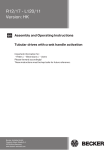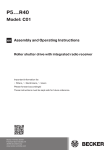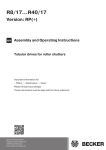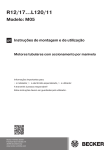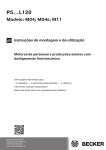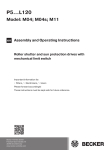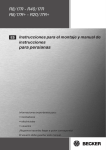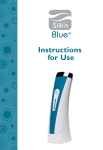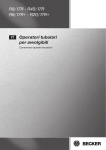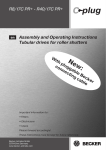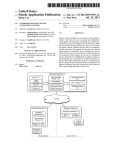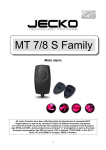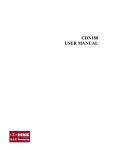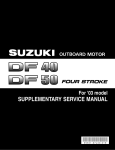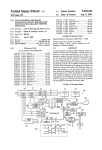Download P5...R40 B01 - Becker
Transcript
P5...R40 Model: B01 en Assembly and Operating Instructions Roller shutter drive with integrated radio transceiver Important information for: • Fitters / • Electricians / • Users Please forward accordingly! These instructions must be kept safe for future reference. Becker-Antriebe GmbH Friedrich-Ebert-Straße 2-4 35764 Sinn/Germany www.becker-antriebe.com Table of contents Contents ............................................................................................................................................................................. 3 General .............................................................................................................................................................................. 3 Warranty ............................................................................................................................................................................. 4 Safety instructions ............................................................................................................................................................... 4 Intended use ....................................................................................................................................................................... 6 Assembling and disassembling the plug-in connecting cable .................................................................................................. 6 Assembling the plug-in connecting cable .................................................................................................................... 6 Disassembling the plug-in connecting cable for tubular drives dia. 35. ........................................................................... 7 Disassembling the plug-in connecting cable for tubular drives dia. 45 and dia. 58 ........................................................... 8 Installation .......................................................................................................................................................................... 9 Assembling the drive ................................................................................................................................................. 9 Undoing the mounting pin .......................................................................................................................................... 9 Drive adapter for obstacle detection ........................................................................................................................... 9 Assembling the drive adapter with drive adapter safety catch ...................................................................................... 10 Assembling the drive adapter with screw connection .................................................................................................. 10 Securing the drive against axial displacement ............................................................................................................ 10 Fixing the drive adapter to the barrel dia. 35 and dia. 45 .............................................................................................. 10 Mounting the drive in the tube .................................................................................................................................. 11 Preparation for Commissioning .......................................................................................................................................... 12 Checking that the running direction is correct ............................................................................................................ 13 Confirming the drive ................................................................................................................................................ 13 Limit position settings and configurations ............................................................................................................................ 14 Obstacle detection ............................................................................................................................................................ 14 Disposal ........................................................................................................................................................................... 14 Maintenance ..................................................................................................................................................................... 14 Technical data dia. 35 ........................................................................................................................................................ 15 Technical data dia. 45 ........................................................................................................................................................ 15 Sample wiring diagram ...................................................................................................................................................... 16 What to do if...? ................................................................................................................................................................. 17 Declaration of Conformity .................................................................................................................................................. 18 2 Contents General These tubular drives are high-quality products with the following features: ▪ Optimised for roller shutter operation ▪ Can be operated with any suitable KNX transmitter ▪ Individual, group and central radio control ▪ No need to run wires to a switch or relay control device ▪ Any combination of drive and transmitter possible ▪ Simple to set the limit positions with the transmitter ▪ Installation without stops possible (from upper point to lower point) ▪ Two freely selectable intermediate positions can be set ▪ Flexible radio grouping; can be altered at any time with no need to install/uninstall ▪ Integrated memory function facilitates easy programming of one or two switching times on daily repeat. ▪ Automatic detection of the lower limit position when using springs in conjunction with the "drive adapter for obstacle detection" ▪ Automatic detection of limit positions thanks to intelligent electronic system with stop systems ▪ Obstacle detection, even when using anti-lifting devices (axle shaft devices) ▪ Secure anti-lifting device ▪ Slight pressure applied to the roller shutter curtain makes it difficult to raise or reach under it ▪ Suitable for rigid aluminium, steel and wooden profiles ▪ The limit positions do not have to be reset: Changes in the shading solution are accommodated automatically when using stop systems. ▪ Torque control in the up direction prevents damage to the roller shutter in the event of a frozen or blocked shutter ▪ Anti-freeze mechanism in the upper limit position can be enabled ▪ Considerably lower stop load, and thus considerably lower shading solution load. ▪ Smooth operation of the system and the drive increases the service life ▪ For plug-in connecting cable ▪ Fly screen protection function Please observe these Assembly and Operating Instructions when installing and setting the equipment. The date of manufacture comes from the first four digits of the serial number. The numbers 1 and 2 indicate the year and the numbers 3 and 4 indicate the calendar week. Example: 24th calendar week in 2012 Ser. No.: 1224XXXXX Explanation of pictograms Caution Denotes a potentially hazardous situation. If this is not avoided, injuries may result. Attention Denotes a potentially hazardous situation. If this is not avoided, the product or some‐ thing in its vicinity may be damaged. Note Denotes user tips and other useful information. Integrated radio receiver Compatible with the B-Tronic control program and suitable control units with bidirec‐ tional KNX radio. 3 Warranty Structural modifications and incorrect installation which are not in accordance with these and our other instructions can result in serious injuries, e.g., crushing of limbs. Therefore, structural modifications may only be carried out with our prior approval and strictly in accordance with our instructions, particularly the information contained in these Assembly and Operating Instructions. Any further processing of the products which does not comply with their intended use is not permitted. The end product manufacturer and fitter have to ensure that all the relevant current statutory, official and, in particular, EMC regu‐ lations are adhered to during utilisation of our products, especially with regard to end product manufacture, installation and cus‐ tomer advice. Safety instructions The following safety instructions and warnings are intended to avert hazards and to prevent property damage and personal injury. Please keep these instructions in a safe place. Caution Important safety instructions for the user. Failure to observe these instructions can lead to serious injuries. ▪ All work, including maintenance and cleaning, on electrical installations as well as other system parts must always be performed by authorised specialists, in particular qualified electricians. ▪ Children from the age of 8 years and persons with reduced physical, sensory or mental capabilities or lack of experience and/or knowledge may use these devices, provided they are supervised or have been in‐ structed in the safe use of the device, and have understood the hazards involved. Children must not play with the device. ▪ Systems have to be checked regularly by authorised specialists for wear and damage. ▪ Always put damaged systems out of operation immediately until they are repaired by an authorised special‐ ist. ▪ Do not operate equipment if people or objects are within the danger zone. ▪ Observe the danger zone of the equipment during operation. ▪ Stop and disconnect the equipment from the mains power supply when maintenance and cleaning is being performed either on the system itself or in the immediate vicinity of it. ▪ Ensure that there is adequate clearance (at least 40 cm) between moving parts and adjacent objects. ▪ Crushing or shearing points must be avoided or protected. 4 Caution Important safety instructions for installation and commissioning Failure to observe these instructions can lead to serious injuries. ▪ Observe the safety instructions in EN 60335-2-97. Please note that this list of safety instructions is not ex‐ haustive, since it would be impossible for the standard to include all sources of danger. For example, the design of the operated product, the way the drive works in the situation it is installed in or even the way the end product is mounted in the end user’s place of use cannot be taken into consideration by the drive man‐ ufacturer. If any questions or uncertainties regarding the safety instructions contained in the standard arise, please contact the manufacturer of the part or end product in question. ▪ All work, including maintenance and cleaning, on electrical installations as well as other system parts must always be performed by authorised specialists, in particular qualified electricians. ▪ When electrical or electronic equipment and units are operated, certain components, e.g., the power sup‐ ply unit, are live. Physical injuries or damage to property can result in the event of unauthorised interven‐ tions or failure to heed warnings. ▪ Be careful when touching the tubular drive, as it heats up during operation for technological reasons. ▪ All applicable standards and regulations for electrical installation must be complied with. ▪ Only use spare parts, tools and accessory devices which have been approved by the drive manufacturer. ▪ Unapproved third-party products or modifications to the system and its accessories represent a risk to your safety and the safety of others. This means that the use of unapproved third-party products, or modifica‐ tions which have not been agreed with or approved by us, are prohibited. We do not accept liability for dam‐ ages or injury arising from such actions. ▪ Before installation, shut down all lines and control devices that are not essential for operation. ▪ Position control devices within sight of the driven product, but away from moving parts, at a height of over 1.5 m. ▪ Permanently mounted control devices must be positioned where they can be seen. ▪ Ensure that there is adequate clearance between moving parts and adjacent objects. ▪ Rated torque and duty cycle must be suitable for the requirements of the driven product. ▪ Technical data – rated torque and service life can be found on the type plate of the tubular drive. ▪ Moving parts of drives must be installed at a height of over 2.5 m above floor level or any other surface from which access to the drive is gained. ▪ Crushing or shearing points must be avoided or protected. ▪ When installing the drive, all-pole disconnection from the mains with a contact gap of at least 3 mm per pole must be provided (EN 60335). ▪ To ensure safe operation of the system after commissioning, the limit positions must be correctly set/ programmed in. ▪ If the drive mains connecting cable is damaged, it must be replaced with the same type of mains connecting cable, which is available from the drive manufacturer. ▪ The drive must not be carried by the mains connecting cable. ▪ Drives with a H05VV-F connecting cable may only be used indoors. ▪ To connect the drive to the driven part, solely mechanical accessory components made by the drive manu‐ facturer from the current product catalogue may be used. The components must be installed in accordance with the manufacturer's instructions. ▪ All latching connections and fastening screws on the brackets must be checked to ensure that they are se‐ cure. ▪ If the drive is used for curtains in a specially marked area (e.g. escape routes, hazard zones, safety areas), compliance with all applicable regulations and standards must be ensured. 5 Intended use The type of tubular drive described in these instructions is intended solely for the operation of roller shutters. This type of tubular drive is compatible with the B-Tronic control program and suitable control units with bidirectional KNX radio. This type of tubular drive supports not only curtain attachment by means of springs but also mechanical anti-lifting devices (e.g., Zurfluh-Feller, Simu, GAH Alberts and Deprat). These are detected automatically. If the springs or the top lath are screwed or riveted to the barrel, a point must be set in the lower limit position. For sun protection applications, please use only the types of tubular drive designed for this purpose. This type of tubular drive is designed for use in single systems (one drive per barrel). The tubular drive must not be used in potentially explosive areas. The mains connecting cable is not suitable for transporting the drive. Always carry the drive by the housing tube. Other applications, uses and modifications are not permitted in order to protect the safety of the users and others, since these actions can impair the system’s safety and carry the risk of personal injury and property damage. The drive manufacturer does not accept liability for damages or injury arising from such actions. Always observe the information in these instructions when operating or repairing the system. The drive manufacturer does not ac‐ cept liability for damages or injury resulting from improper usage. Attention Only use anti-lifting devices if the roller shutter laths are sufficiently strong. The closed curtain must not project beyond the guide tracks or else there is a risk of the joint between the top two laths being subjected to excessive strain and getting damaged. Assembling and disassembling the plug-in connecting cable Assembling the plug-in connecting cable Insert the dead connecting cable into the drive head until the locating lug clicks into place in the drive. If necessary, use a suitable flathead screwdriver to assist with insertion. Set the screwdriver into one of the two plug grooves provided for this purpose. Check that the cable is properly engaged. 1 = locating lug 6 Disassembling the plug-in connecting cable for tubular drives dia. 35. Caution Prior to disassembly, the power supply to the connecting cable must be disconnected. On drives with a diameter Ø35, insert a suitable flathead screwdriver between the locating lug and the snap-in pin, so that the snap-in pin releases the locating lug from the plug. Now you can pull out the connecting cable along with the flathead screwdriver. Ø35 A A = snap-in pin 7 Disassembling the plug-in connecting cable for tubular drives dia. 45 and dia. 58 Caution Prior to disassembly, the power supply to the connecting cable must be disconnected. On drives with a diameter Ø45 or Ø58, insert a suitable flathead screwdriver right into the recess of the locating latch, so that the latch releases the locating lug from the plug. Now you can pull out the connecting cable along with the flathead screwdriver. dia. 45 and dia. 58 1. A 2. A = locating latch 8 Installation Assembling the drive Attention To connect the drive to the driven part, solely mechanical accessory components made by the drive manufac‐ turer from the current product catalogue may be used. Prior to mounting, the fitter must ensure that the masonry and the system being motorised are sufficiently robust (drive torque plus weight of the shading solution). Caution Electrical connections may only be carried out by a qualified electrician. Prior to assembly, the power supply must be disconnected and secured. Please give the enclosed connection information to the responsible elec‐ trical contractor. These drives cannot be operated with conventional switching elements (switches, timers and the like). If you want the roller shutter curtain to open to the upper stop, proceed as follows: The roller shutter curtain must be prevented from being drawn into the shutter box with a mechanical stop or an angled end strip. With face-fixed elements, we recommend concealed stops in the guide tracks. Calculate the space required at the side (M) by measuring the drive head and wall bracket. The clear dimension of the box (X) minus the space required at the side (M) and idler (G) gives the length (L) of the barrel: L=X-M-G. The space required at the side (M) varies depending on the combination of drive and wall bracket. Then mount the wall bracket and idler. Ensure that the barrel is aligned at right angles to the wall and that sufficient axial play is allowed for the mounted system. Attention When using anti-lifting devices, closed brackets must be fitted. The tubular drive presses the closed curtain down to make it difficult for people to reach under it or raise it. Only use curtains made of sufficiently strong material, such as aluminium, steel or wood. To prevent damage to the curtain it must run in guide tracks from top to bottom. Undoing the mounting pin When pushed in, the mounting pin (2) locks automatically. To undo the mounting pin (2), push the tab washer (1) upwards and pull out the mounting pin (2). Drive adapter for obstacle detection Note If you wish to use the "obstacle detection" function, you must use the "drive adapter for obstacle detection". 9 Assembling the drive adapter with drive adapter safety catch Put the drive adapter (1) onto the drive shaft of the tubular drive. You can see which way to insert the safety catch (2) from its shape. When inserting the drive adapter safety catch (2) into the hole (4), make sure that the locking lug (3) engages. You will hear a click. Check that the safety catch is securely in position by pulling on the drive adapter (1). Assembling the drive adapter with screw connection Put the drive adapter (1) onto the drive shaft of the tubular drive. For the assembly, use an M6 x 12 screw (3) with appropriate washer (2) and suitable screw retainer. Threaded hole (4) Securing the drive against axial displacement In order to secure the drive against axial displacement, we recommend screwing the drive adapter to the tube. -10 mm Attention When drilling into the barrel, never drill near the tubular drive! Fixing the drive adapter to the barrel dia. 35 and dia. 45 Size of drive [mm] Diameter of barrel [mm] Torque max. [Nm] Fastening screws for drive adapter (4 pc.) dia. 35 40 mm plastic drive adapter 13 self-tapping screw dia. 4.8 x 9.5 mm dia. 45 60 - 70 mm plastic or diecast drive adapter 40 self-tapping screw dia. 4.8 x 9.5 mm We also recommend screwing the idler to the barrel. Attention Do not hammer or drop the tubular drive into the barrel! The curtain can only be secured using springs or antilifting devices. 10 Mounting the drive in the tube For profile tubes: In the case of some drive adapters, tolerances of the groove widths in different bar‐ rels can be offset by rotating the drive adapter into a different groove recess. These groove recesses have different sizes and allow the drive to fit exactly. For round tubes: First notch the tube on the motor side, so the lug of the thrust ring can also be pushed into the tube. There must be no play between the lug of the thrust ring and the tube. Assemble the tubular drive with the relevant thrust ring (1) and drive adapter (2). In‐ sert the tubular drive with the pre-assembled thrust ring and drive adapter into the tube to achieve a form fit. Ensure that the thrust ring and drive adapter are secure in the tube. Mount the assembled unit comprising barrel, tubular drive and idler on the box and secure the drive according to the type of wall bracket fixing with a split or spring pin. After programming the transmitter, position the barrel so that the roller shutter curtain can be mounted with springs or fit the antilifting device in accordance with the manufacturer's instructions. Note When using springs/anti-lifting devices, we recommend you use at least three; for longer tubes, use three springs/anti-lifting devices per meter of barrel. Lay the connecting cable Lay the connecting cable up to the tubular drive, and fix The connecting cable and any antennae must not project into the winding chamber. Cover any sharp edges. 11 Preparation for Commissioning The tubular drive can be operated with any suitable KNX transmitter The commissioning (e.g. setting the limit positions etc.) and later configurations are, however, only possible with a B-Tronic trans‐ mitter. Note The running direction must be correct. When setting the limit positions, the tubular drive runs with the limit po‐ sition status indicator. The upper limit position must always be set first. When setting the upper limit position, ensure that the roller shutter curtain is not pulled out of the guide tracks. When first installing, using springs and adjusting the limit position ‘...to lower stop’, the barrel in the lower lim‐ it position turns approx. 1/4 of a turn further than usual. In doing so, the tubular drive is able to detect the use of anti-lifting devices or springs automatically. The tubular drive switches off automatically. Limit position status indicator A brief stopping and restarting indicates that no limit position has been set in that direction of movement. Completion of installation following automatic setting of limit positions The drive saves the limit position permanently once the upper limit position is reached 3 times in succession. Installation is then complete. If the limit position is set above a point, this is stored permanently. Explanation of symbols 1 = direction switch 2 = radio switch Connecting the tubular drive Connect the tubular drive to the power supply. 230V AC / 50 Hz N L1 PE 1 1 2 2 3 4 4 1 = blue 3 = black 2 = brown 4 = green-yellow Note If several tubular drives are to be connected in parallel, you can deactivate the programming mode on one tub‐ ular drive by switching the radio switch to the outside position after turning the power on. If the radio switch is already in this position, switch it to the inside and back to the outside position. Readying the tubular drive for programming Readying the tubular drive for programming by switching on the power Switch on the power. Æ The tubular drive is ready to program for 3 minutes Readying the tubular drive for programming with the radio switch Switch the radio switch to the inside position. If the radio switch is already in this posi‐ tion, switch it to the outside and back to the inside position. Æ The tubular drive is ready to program for 3 minutes Put the tubular drive into programming mode with a programmed B‑Tronic transmitter Please find the appropriate description in the instructions for the B-Tronic transmit‐ ter. 12 Checking that the running direction is correct Note It is only possible to change the direction of rotation if no limit position has been set. Press the UP or DOWN button [ The shading solution runs in the desired direction. Æ Direction switch is OK. If the shading solution runs in the wrong direction, the running direction must be switched. Proceed as follows: Switch the direction switch (1) to the opposite position. Æ The shutter direction is now changed. Check the shutter direction again. Confirming the drive The drive confirms each programming and deletion action. The tubular drive does this through a small movement that can be per‐ ceived (audibly) as "clicking" or (visually) as "waving". 13 Limit position settings and configurations The commissioning (e.g. setting the limit positions etc.) and later configurations are only possible with a B-Tronic transmitter. Please find the appropriate description in the instructions for the B-Tronic transmitter. Attention When operating the tubular drive without the drive adapter for obstacle detection, if using springs a point must be set in the lower limit position. Possible limit position settings ▪ Upper stop to lower stop ▪ Upper point to lower point ▪ Upper stop to lower point ▪ Upper point to lower stop The limit position becomes fixed after the tubular drive has turned off automatically in the desired position three times. Possible configurations ▪ Intermediate positions I+II ▪ Memory function ▪ Upper anti-freeze mechanism ▪ Fly screen protection function ▪ Repeater mode Obstacle detection Caution Obstacle detection is only active in conjunction with the “drive adapter for obstacle detection”. In addition, please note that the drive must be pushed in to the shaft as far as the band of the thrust ring. Use of the drive’s obstacle detection system as personal protection is not permitted. It has been designed ex‐ clusively to protect the roller shutters or sun protection system from being damaged. If the drive is correctly installed, it switches off when it detects obstructions or shutter faults and reverses a short way in the oppo‐ site direction. The following are detected: In the DOWN direction ▪ A curtain jam when closing due to objects on the window sill or sticking of the lateral guide tracks. In the UP direction ▪ Extremely large increase in the load (e.g., ice on the end strip) To ensure that the roller shutter curtain safely enters the guide tracks, obstacle detection is inactive for approx. 1.5 revolutions of the barrel from the upper limit position. To ensure complete closing of the roller shutter curtain at the lower limit position, the curtain does not reverse once it gets to ap‐ prox. 260° (dia. 35) and 210° (dia. 45) from the lower limit position. Disposal This product is made of various materials which must be disposed of properly. Find out about the applicable regulations on recy‐ cling or disposal for this product in your country. The packaging material must be disposed of properly. Maintenance These drives are maintenance-free. 14 Technical data dia. 35 Model P5-B01 P9-B01 P5/16C PROF+ KNX P9/16C PROF+ KNX Rated torque [Nm] 5 9 Output speed [rpm] 16 16 Type Limit switch range 64 revolutions Supply voltage 230 V AC / 50 Hz Connected load [W] Rated current consumption [A] 85 110 0.36 0.47 Mode S2 4 min Degree of protection IP 44 Min. tube inside diameter [mm] 37 Frequency 868.3 MHz Max. number of transmitters 40 Emission sound pressure level [dB(A)] ≤ 70 Technical data dia. 45 Model R8-B01 R12-B01 R20-B01 R30-B01 R40-B01 R8/17C PROF+ KNX R12/17C PROF+ KNX R20/17C PROF+ KNX R30/17C PROF+ KNX R40/17C PROF+ KNX Rated torque [Nm] 8 12 20 30 40 Output speed [rpm] 17 17 17 17 17 Type Limit switch range 64 revolutions Supply voltage 230 V AC / 50 Hz Connected load [W] 100 110 160 205 260 Rated current consumption [A] 0.45 0.5 0.75 0.9 1.15 Mode Degree of protection Min. tube inside diameter [mm] Frequency Max. number of transmitters Emission sound pressure level [dB(A)] S2 4 min IP 44 47 868.3 MHz 40 ≤ 70 15 16 Green/yellow Blue Brown Black Electronics Sample wiring diagram L N PE What to do if...? Problem Tubular drive is not functioning. Cause Remedy No transmitter programmed. Program new transmitter. Transmitter is out of range of the tubular drive. Bring transmitter within range of the tubu‐ lar drive. Batteries in transmitter not inserted/ in‐ serted incorrectly or dead. Insert batteries correctly or insert new batteries. Electrical connection is faulty. Check electrical connection. Thermal protection switch in tubular drive Wait until the thermal protection switch in has tripped. the tubular drive is reactivated. Running direction on tubular drive cannot Limit positions are stored in the tubular be set. drive. Delete limit positions and reset the run‐ ning direction. Incorrect running direction after deleting limit positions. Direction switch is in the wrong position. Switch the direction switch to the oppo‐ site position. Tubular drive stops arbitrarily; cannot be restarted in the same direction. Tubular drive has detected an increase in load. Briefly run the curtain in the opposite di‐ rection, then continue in the desired di‐ rection. Tubular drive is overloaded. Use a higher-torque tubular drive. Tubular drive does not operate at the set switching time. Tubular drive is in manual mode. Use a B-Tronic transmitter to switch the tubular drive into automatic mode. Set switching times change. Frequent 230 V AC power cuts. Fluctuations in the 50 Hz mains frequen‐ cy. During the programming run, the drive stops short of the limit position to be pro‐ grammed. For safety reasons, the drive reacts sensi‐ Briefly run curtain DOWN and subse‐ tively to unsmooth running during the quently UP until you reach the upper limit programming run, in order to prevent position. damage. Ventilation slots of the roller shutter do not close fully. Unsmooth running of the roller shutter near the lower stop and setting of the “lower stop” limit position. Delete the limit positions and set the limit positions as per "to lower point". In this case, first program the lower limit position (lower point) and secondly the upper limit position. 17 Declaration of Conformity 18 19 2010 300 564 0 21/10/2013




















